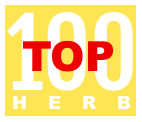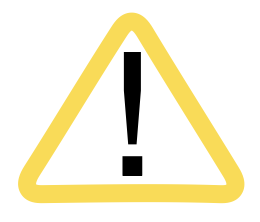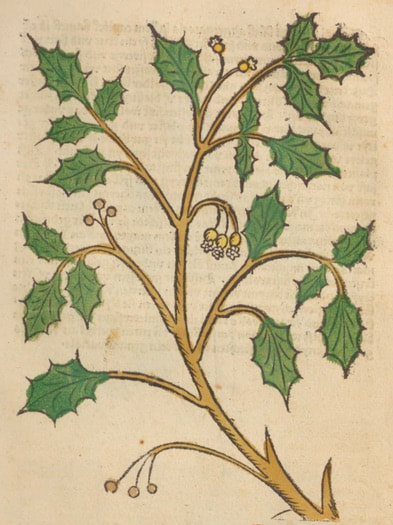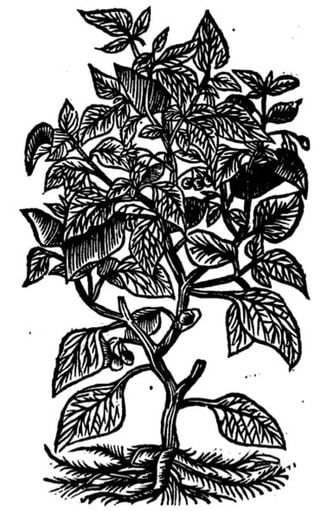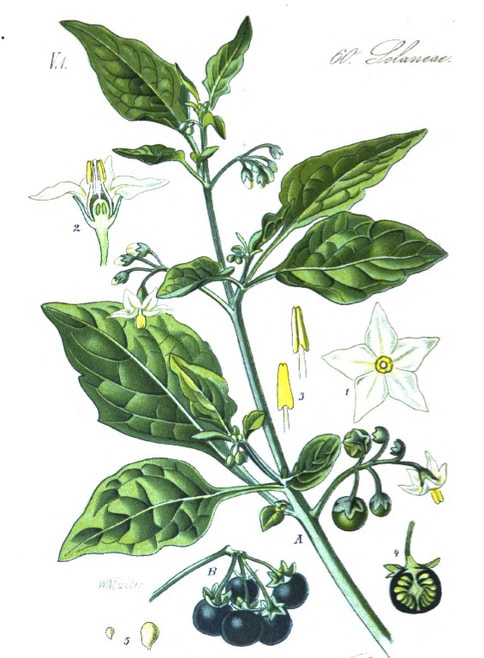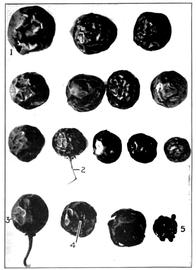Sentry Page Protection
Parkinson, Theatrum Botanicum, 1640
Flora von Deutschland (16), Kohler, 1884
SOLANUM FRUIT
1. Fruits of variable size. 2. Pedicle and persistent calyx.
3. Sunken surface of the fruit. 4. Pedicle scar. 5. Seed.
Squibb's Atlas of the Official Drugs, Mansfield, 1919
1. Fruits of variable size. 2. Pedicle and persistent calyx.
3. Sunken surface of the fruit. 4. Pedicle scar. 5. Seed.
Squibb's Atlas of the Official Drugs, Mansfield, 1919
See also:
Solanum nigrum in Cancer Treatment
A review of the use of Solanum nigrum in the treatment
of Cancer with research and historical usage.
A revision of the Old World Black Nightshades
A useful review of Solanum nigrum and allied species
Solanum nigrum in Cancer Treatment
A review of the use of Solanum nigrum in the treatment
of Cancer with research and historical usage.
A revision of the Old World Black Nightshades
A useful review of Solanum nigrum and allied species
Botanical name:
Solanum nigrum
Parts used:
Whole Herb; Root; Ripe fruit
Temperature & Taste:
Cool, Dry (but 'slippery'). Bitter, slightly Sweet and Pungent. Slightly Toxic
Classifications:
2N. REPELLENT
3B. FEBRIFUGE & ANTIPYRETIC
4g. HEPATIC. 4j. NERVINE
TCM:
B. Clears Heat and Toxin
Constituents:
1. Glycoprotein (70% carbohydrate, 30% protein, more than 50% hydrophobic amnio acids inc. glycine and proline);
2. Steroidal Alkaloids (0.6-2%)
5. Polysaccharides
6. Coumarins
9. Ash (10%), Minerals K, Ca (99-442mg/100g), Fe (1-4mg/100g), S, P; Phosphorus 75mg/100g in the leaf, 62mg/100 g in the seed; Sulphur 8mg/100g in the leaf, 14mg/100g in the seed; Nitrates and nitrites (which are thought to contribute to its toxicity) (29-400mg/100g). Nitrate levels reach their peak as the plant comes into flower
10. Vitamins: C (20-158mg/100g), B, E, A, beta-carotene (2-11mg/100g), Folic acid
11. Rich in Polyphenols, Tannins (to 10%), crude fiber (6%).
12. Fruit also contains Acetylcholine (250mcg/gm)
13. Anthocyanin pigments; the major pigment (93%) in the fruit is petanin.
Solanum nigrum
Parts used:
Whole Herb; Root; Ripe fruit
Temperature & Taste:
Cool, Dry (but 'slippery'). Bitter, slightly Sweet and Pungent. Slightly Toxic
Classifications:
2N. REPELLENT
3B. FEBRIFUGE & ANTIPYRETIC
4g. HEPATIC. 4j. NERVINE
TCM:
B. Clears Heat and Toxin
Constituents:
1. Glycoprotein (70% carbohydrate, 30% protein, more than 50% hydrophobic amnio acids inc. glycine and proline);
2. Steroidal Alkaloids (0.6-2%)
- solanine [highest in unripe fruit and mature leaves]
- solasodine [highest in the root, stem and leaf; 0.65% in the unripe fruit]
- solamargine, solasonine, solanigrines, solanigridine
- tigogenin [highest in the fruit]
- diosgenin [1.2% in the unripe fruit]
- degalactotigonin (cytotoxic see here)
- solanigrosides
- nigrumnins
- uttroside A and B are found in the stems and roots
5. Polysaccharides
6. Coumarins
- scopoletin
- Lingans–pinoresinol, syringaresinol, medioresinol
9. Ash (10%), Minerals K, Ca (99-442mg/100g), Fe (1-4mg/100g), S, P; Phosphorus 75mg/100g in the leaf, 62mg/100 g in the seed; Sulphur 8mg/100g in the leaf, 14mg/100g in the seed; Nitrates and nitrites (which are thought to contribute to its toxicity) (29-400mg/100g). Nitrate levels reach their peak as the plant comes into flower
10. Vitamins: C (20-158mg/100g), B, E, A, beta-carotene (2-11mg/100g), Folic acid
11. Rich in Polyphenols, Tannins (to 10%), crude fiber (6%).
12. Fruit also contains Acetylcholine (250mcg/gm)
13. Anthocyanin pigments; the major pigment (93%) in the fruit is petanin.
Uses:
1. Clears Heat and Poison, Reduces Swelling (West, Ayurveda, TCM):
-Acne, Abscesses, Psoriasis, Eczema, open Sores etc. Very useful for various heat-type skin diseases.
-Liver or Spleen Swelling, Jaundice and certain types of Fever;
-equal to Belladonna in the treatment of Scarlet Fever.
-in TCM for Acute Hepatitis, and Ayurveda recognises it as a useful herb for Cirrhosis.
-toxic effect of Mineral medicines (Li Shi Zhen)
2. Clears Heat and Poison, Moves the Blood, Resolves Masses (West, Ayurveda, TCM):
-'eliminates Heat and disperses blood stasis'. (Li Shi Zhen)
-Inflammation and Tumor, especially those of the Liver, Spleen, Testicles, Uterus and Breast
-much used for Cancer; clinically useful in Cancers of the Cervix, Ovary, Esophagus, Breast, Lung, Liver, Urinary Bladder, Chorioepithelioma, Sarcoma, various Leukemias, etc. Recognised in China and Russia as one of the more important anti-cancer herbs
-proven effective against some chemotherapy-resistant cancer strains; works synergistically with some modern Chemotherapy agents.
3. Clears Wind and Heat, Stops Spasms, Eases Pain, Promotes Rest:
-Epilepsy, Cramps, Spasms, and Insomnia.
-heat-type pain including pains of the head, Gout and Sciatica; used for wind diseases. (West, TCM)
-root has been used as a stand-alone medicine for Insomnia in India; Salmon noted the root is hypnotic.
4. Clears Phlegm and Heat, Stops Wheezing (West, Ayurveda, TCM):
-Cough, Wheezing and Asthma associated with excess phlegm, especially of a hot nature.
-chronic Bronchitis; also Tuberculosis. (TCM)
5. Clears Heat and Damp, Promotes Urine (West, Ayurveda, TCM):
-heat-type Edema or Strangury;
-Sciatica, Gout, Leukorrhea.
-Kidney and Bladder inflammations.
6. Moves the Blood, Stops Pain (West, Ayurveda, TCM):
-Angina Pectoris and Heart Disease.
-Heart disease with leg swelling. (Ayurveda)
-Small doses increase cardiac activity; large doses depress cardiac activity
-decoction is used in India for difficult Parturition.
7. Regulates Stomach, Benefits Digestion:
-‘It corrects disordered processes of nutrition by which the organism ingests, digests, absorbs, transports, utilises and excretes food substances, and restores the normal function of the system’.
-Good for digestive disorders including Mal-absorption, Colitis, Flatulence, and Peptic Ulcers.
-'relieves general fatigue' (Tang Ben Cao)
-'tonifies Yuan Qi of men'. (Su Song)
8. Promotes Conception:
-To promote Conception, the juice has been given (Ayurveda)
9. Externally:
-applied to Herpes, Shingles, Ringworm,
-Fretting and Corroding Ulcers.
-Arabian doctors apply the bruised fresh leaves to Burns and Ulcers; the cool decoction has been used topically also.
-applied as a paste to various inflammatory, infectious and chronic Skin Diseases including Abscesses, Eczema, Psoriasis etc. Juice or pulp of the fresh plant is used in Ayurveda as an application to Leprous skin.
-bruised fresh fruit an seed is applied to Freckles to remove them, and to improve complexion.
-fresh leaves, juice, oil or poultice is applied to Hemorrhoids.
-heat-type pain, hot Inflammation or Tumor including those of the Breast, Testicles, Lymph Nodes, Glands etc. (fresh leaves heated on a plate and applied; or oil, ointment, plaster etc.)
-the fresh leaves beaten are applied to Gout, Arthritic and Rheumatic joints.
-the juice or water can be dropped into the ear for Earache
-the juice or distilled water was mixed with vinegar as a mouth wash and gargle for the Mouth and Throat, and for swollen Glands or Tonsils.
-a major herb for external application to Fibroid Tumors and Cancers; ‘The juice is very good in a Cancer, to wash the same’. (Pharmacopoeia Universalis, James, London, 1743)
-vaginal douche for Tumors and Swellings of the Vagina or Uterus, including Cervical Cancer.
-the hot juice of the leaves is applied to swollen Breasts.
-widely used to promote healing of Wounds.
-Gangrene, bruise the leaves with Salt or Niter and apply.
-juice is anointed on around the eyes to slightly dilate the pupil, being milder than, but similar to Belladonna.
Dose:
1. Boiling reduces Toxicity. Solanine, the main toxic alkaloid, is destroyed by boiling. Likewise the distilled water, which was often the preferred preparation for internal use in Europe and Unani, has been heated to boiling.
2. Leclerc said the fresh leaves were far more effective as the dried leaves lose a lot of their potency.
3. Most often when the juice was listed in old European formulae, the juice that had been clarified by boiling to remove scum was used. In this case, the toxic constituents are greatly reduced or eliminated.
4. Despite the fact that it is usually used in fairly small doses, especially when fresh, it will be noticed that the fresh leaf juice is used in doses of up to half a pint in India (after boiling to a reddish-brown color), and has been used in large doses as a douche for Cancer of the Womb. Note that when ‘leaf juice’ is used, young fresh leaves are selected and no green berries are included. Green berries contain highest levels of toxic alkaloids with the mature leaves also having higher quantities.
5. There is a greater variation in doses of various preparations given by various authors regarding the use of this plant than with almost any other herbal medicine. Some plants may be far more potent or active, and it is also noted that certain compounds degrade rapidly either during drying or after boiling. Therefore, smaller, more conservative doses should be used to begin with and increased every day or two until a desired dose is reached. This is especially so in the treatment of Cancer where ever-increasing doses may be required, watching carefully for any undesirable side-effects.
6. The dried leaf and dried ripe fruit may be used in similar doses. However, the dried leaf may still contain levels of toxic alkaloids, whereas the dried ripe fruit is said to be devoid of these. As noted, drying reduces the toxic alkaloid content of the leaf, however.
7. According to Ben Cao Gang Mu, the stem, leaf and root all share similar properties.
LEAF in INFUSION: 100–300mg (up to 1 or 2 grams has been given). 1–2 grains (65–130mg) of the dried leaf steeped in boiling water is said to be strongly diaphoretic and sudorific. In India, a hot infusion of 100–250mg of the dried leaf is also given for Fever;
DRIED HERB in DECOCTION (containing dried leaf and stem): 3–9 grams, up to 15 grams (9–30 grams fresh), up to 30–60 grams (90–150 grams of the fresh plant) in severe cases such as in the treatment of Cancer has been used (TCM);
ROOT in DECOCTION: 10–20 grams (Ayurvedic Pharmacopoeia of India), Salmon said 1 dram of the root bark is Hypnotic.
PREPARED LEAF JUICE: 5–10 mls. to 20 mls. In India, the fresh juice is gently heated until it becomes red-brown. This is given in doses of 6–8 oz. for swelling of the Liver and Spleen, Tumors etc.;
TINCTURE of the HERB (1:5): 1–3 mls, 2–3 times daily, or ½–5 drops, every 2 or 3 hours; some have used doses of 10–20 drops.
FLUID EXTRACT made of the WHOLE PLANT (berries, leaf and stem) has been used in doses of half to 2 drams (Nadkarni);
DRIED RIPE FRUIT: 5–7 grams;
POWDER of the LEAF: 100–500mg (up to 1 gram);
Correctives:
Sugar, Honey. (Unani)
Substitutes:
1. Winter Cherry (Unani)
2. Belladonna for external uses.
3. In India, Unani and elsewhere, local species of Solanum are used similarly to Black Nightshade.
1. Boiling reduces Toxicity. Solanine, the main toxic alkaloid, is destroyed by boiling. Likewise the distilled water, which was often the preferred preparation for internal use in Europe and Unani, has been heated to boiling.
2. Leclerc said the fresh leaves were far more effective as the dried leaves lose a lot of their potency.
3. Most often when the juice was listed in old European formulae, the juice that had been clarified by boiling to remove scum was used. In this case, the toxic constituents are greatly reduced or eliminated.
4. Despite the fact that it is usually used in fairly small doses, especially when fresh, it will be noticed that the fresh leaf juice is used in doses of up to half a pint in India (after boiling to a reddish-brown color), and has been used in large doses as a douche for Cancer of the Womb. Note that when ‘leaf juice’ is used, young fresh leaves are selected and no green berries are included. Green berries contain highest levels of toxic alkaloids with the mature leaves also having higher quantities.
5. There is a greater variation in doses of various preparations given by various authors regarding the use of this plant than with almost any other herbal medicine. Some plants may be far more potent or active, and it is also noted that certain compounds degrade rapidly either during drying or after boiling. Therefore, smaller, more conservative doses should be used to begin with and increased every day or two until a desired dose is reached. This is especially so in the treatment of Cancer where ever-increasing doses may be required, watching carefully for any undesirable side-effects.
6. The dried leaf and dried ripe fruit may be used in similar doses. However, the dried leaf may still contain levels of toxic alkaloids, whereas the dried ripe fruit is said to be devoid of these. As noted, drying reduces the toxic alkaloid content of the leaf, however.
7. According to Ben Cao Gang Mu, the stem, leaf and root all share similar properties.
LEAF in INFUSION: 100–300mg (up to 1 or 2 grams has been given). 1–2 grains (65–130mg) of the dried leaf steeped in boiling water is said to be strongly diaphoretic and sudorific. In India, a hot infusion of 100–250mg of the dried leaf is also given for Fever;
DRIED HERB in DECOCTION (containing dried leaf and stem): 3–9 grams, up to 15 grams (9–30 grams fresh), up to 30–60 grams (90–150 grams of the fresh plant) in severe cases such as in the treatment of Cancer has been used (TCM);
ROOT in DECOCTION: 10–20 grams (Ayurvedic Pharmacopoeia of India), Salmon said 1 dram of the root bark is Hypnotic.
PREPARED LEAF JUICE: 5–10 mls. to 20 mls. In India, the fresh juice is gently heated until it becomes red-brown. This is given in doses of 6–8 oz. for swelling of the Liver and Spleen, Tumors etc.;
TINCTURE of the HERB (1:5): 1–3 mls, 2–3 times daily, or ½–5 drops, every 2 or 3 hours; some have used doses of 10–20 drops.
FLUID EXTRACT made of the WHOLE PLANT (berries, leaf and stem) has been used in doses of half to 2 drams (Nadkarni);
DRIED RIPE FRUIT: 5–7 grams;
POWDER of the LEAF: 100–500mg (up to 1 gram);
Correctives:
Sugar, Honey. (Unani)
Substitutes:
1. Winter Cherry (Unani)
2. Belladonna for external uses.
3. In India, Unani and elsewhere, local species of Solanum are used similarly to Black Nightshade.
Main Combinations:
Heat / Toxin
1. Fever, combine distilled waters of Elder flower, Black Nightshade and Coltsfoot (Culpeper)
2. Skin diseases, Albizia bark with Gossypium flowers, Cassia Fistula leaf and Black Nightshade (Charaka, Sushrata),
3. Acne, Black Nightshade with Tinospora, Madder, Hemidesmus, Neem (Azardirachta indica), Catechu (Patent with proven effect)
4. Scrofula, Black Nightshade with Figwort.
5. Urticaria, Ginger powder is triturated with Black Nightshade juice and dried. (Ayurveda)
6. Hot inflammatory tumors and swellings, Houseleek with Purslane, Nightshade, Rose and Willow leaf
7. To clear Heat from the Liver and Blood, Black Nightshade with Endive, Dodder, Senna
8. Liver disease:
i. Black Nightshade with Nepeta hindostana, Yarrow, Fennel seed, Raisins (Unani)
ii. Black Nightshade fruit, Yarrow, Fumitory, Swertia, Chicory, Dodder seed, Rose, Rhubarb, Agrimony (Unani)
9. Hepatitis:
i. Hepatitis and Cirrhosis, with Chicory, Black Nightshade, Yarrow (Ayurveda)
ii. Acute Viral Hepatitis, Mesua flower with Yarrow, Agrimony, Rhubarb, Chicory root & seed, Dodder seed, Fumitory, Black Nightshade, Swertia (as in Kabdeen, a patent Unani Medicine)
iii. Black Nightshade with Caper root bark, Cassia seed, Yarrow, Tamarisk (as in Liv-52, a patent medicine with proven efficacy against Hepatitis, especially Hepatitis B)
10. To promote Urine, Black Nightshade, Akebia Mu Tong, Coriander (Hu Sui). Decct. (Su Song)
11. Cough with emaciation, Ripe fruit of Black Nightshade, Himalayan Cherry kernel (Prunus cerasoides), Raisins, Long Pepper, made into a linctus with Honey and Ghee. (The Bower Manuscript, Ayurveda)
Cancer
12. Cancer:
i. Black Nightshade with Agrimony (TCM)
ii. Black Nightshade with Agrimony, Dodder, Herb Robert, Yarrow
iii. Black Nightshade, Agrimony, Fumitory, Figwort, Dodder, Violet, Elecampane
iv. Astragalus Huang Qi with Hedyotis Bai Hua She She Cao, Black Nightshade (Long Kui) (TCM)
v. Thuja with Dodder, Agrimony, Black Nightshade
vi. Lung, Black Nightshade, Cordyceps, Taxus (Chinese patent remedy)
vii. Cancer of abdominal organs, Black Nightshade with Sparganium San Leng with Zedoary (E Zhu), Costus Mu Xiang, Agrimony (Xian He Cao)
viii. general for Cancer, Scutellaria barbata Ban Zhi Lian with Black Nightshade (Long Kui), Agrimony (Xian He Cao)
ix. Black Nightshade with Agrimonia pilosa, Patrinia scabiosaefolia Guan Chang Fu Fang.
x. Gastric or Esophageal Cancer from Phlegm and Heat with Qi and Blood stagnation, Black Nightshade with Hedyotis Bai Hua She She Cao, Dandelion (Pu Gong Ying), Scutellaria barbata Ban Zhi Lian, Sophora Ku Shen, Rhubarb (Da Huang), Frankincense (Ru Xiang), Astragalus Huang Qi (as in Jin Pu Jiao Nong)
xi. Cancer, later-stage Gastric Cancer, Esophageal Cancer: Black Nightshade with Bezoar (artificial), Lonicera Jin Yin Hua, Centipede (Wu Gong), Dandelion (Pu Gong Ying), Scutellaria barbata Ban Zhi Lian, Toad Venom, Pearl, Rhubarb (Da Huang), Olibanum, Myrrh, Corydalis Yan Hu Suo, Safflower (Hong Hua), Pinellia ginger-processed Ban Xia, Codonopsis Dang Shen, Astragalus Huang Qi, Amomum Sha Ren (as in Jin Pu Jiao Nang of the Chinese Pharmacopoeia)
xii. Ulcerated Cancer, Black Nightshade with Filipendula, Sorrel, Figwort, Agrimony with Alum and Camphor topically (as in Drying Water)
xiii. Topically to skin cancers, Thuja with Black Nightshade, applied as a tincture
13. A douche for Uterine and Cervical Cancer:
i. juices of Black Nightshade, Plantain and Purslane, mucilage of Fleabane and Oil of Rose
ii. Paul's Betony with Black Nightshade, Plantain and Barley water, to which White Troches of Rhasis are added (Riverius)
Externally:
14. Externally for Pain:
i. dried leaves of Black Nightshade (2 oz.), Poppy heads (4), Water (2 lbs.). Boil, strain. Used as a fomentation, wash, injection or enema for pain. (Ratier)
ii. Mandrake juice with Henbane seed, Black Nightshade juice, Water Lily juice, Lettuce juice, Camphor (as in Somniferos Sponge)
15. Toxic Sores:
i. Black Nightshade, Frankincense, Coptis Huang Lian, Apricot kernel (TCM)
ii. Black Nightshade, Henbane, Coriander, Apricot kernel (TCM)
Major Formulas:
Triphera Persica (Mesue)
Troches of Nightshade
Tincture for Tumors of the Testicles from Heat
Plaster for Cancer (Wirtzung)
Balsamum Tranquillum:
i. Datura, Black Nightshade, Belladonna, Henbane, White Poppy (each 4 oz.), boil slowly in Olive oil (6 pounds); strain and press and pour onto Rosemary, Sage, Rue, Wormwood, Hyssop, Thyme, Marjoram, Water Mint, Elder leaf, St. Johns wort (of each 1 oz.). Macerate together for several months. (Pharmacopoeia Gallica, 1818)
ii. Fresh leaves of Datura, Garden Nightshade, Poke root, Belladonna, Mandrake, Henbane (4 oz. each), Poppy (8 oz.), Persicaria (1 oz.), Toads (5), Olive oil (60 oz.) Boil to the consumption of the humidity, strain the liquid on fresh: Rosemary, Sage, Rue, Hyssop, Lavender, Thyme, Marjoram, Balsamita odorata, St. Johns wort (of each 1 oz.), Fresh Wormwood tops (2 oz.), Fresh Elder leaf (1 oz.). Digest for 15 days, decant. (Pharmacopoeia Generalis, 1783)
iii. Fresh leaves of Wormwood, Lavender, Marjoram, Water Mint, Rue, Rosemary, Sage, Tansy, Thyme (each 1 part), Belladonna, Henbane, Mandrake, Garden Nightshade, Tobacco, White Poppy, Datura, Elder (of each 4 parts). Bruise, mix with a little water, express the juice, set aside, decant, coagulate in a water bath, keep apart the green fecula, wash it with cold water, and heat it slightly with Beef Marrow (98 parts). Dissipate the humidity completely, set aside, decant. (Pharmacopee Usuelle, Louvain, 1821)
iv. Fresh Toads (2), Leaves of Garden Nightshade, Henbane, Mandrake, Tobacco, Dwarf Elder, Willow (2 handfuls each), Olive oil (6 pounds). Boil slowly to the consumption of the humidity, and infuse in the expressed oil 2 fresh Toads. Wormwood, Calamint, Hyssop, Marjoram, Rue, Tansy, Rosemary, Sage, Lavender, St. Johns wort, Elder flower (of each 1 handful). After 24 hours digestion in a water bath, strain and press. (Saunders)
Cautions:
1. Toxic in overdose. The unripe fruit are most toxic but the ripe fruit are totally harmless and have been used as food. Young leaves are relatively non-toxic, the toxicity increasing with age. Solanine, the main toxic alkaloid, is destroyed by boiling. The distilled water was the most preferred method of use in the 17th century in England and Europe, the decoction being used in TCM; both these preparations require boiling. Likewise, as per traditional requirements, when the juice was used, this referred to the fresh juice which has been boiled gently, then left to settle, the clear juice (scum and sediment removed) being kept for use.
2. There is much variation in toxicity; due to part of the plant used, preparation and dosage form, age when harvested, as well as geographic location.
Toxicity:
1. Symptoms of poisoning include nausea, vomiting, cramping, headache, diarrhea, severe thirst, tachycardia, arrhythmia, and hypotension; in more severe cases, delirium, agitation, visual disturbance with dilation of pupils, and unconsciousness. Signs of toxicity appear within 6 hours of ingestion.
2. Solanine is toxic in doses of 200–400mg.
3. LD50 of decoction of Solanum nigrum orally in rats is 144 g/kg.
4. A case of Acute Nephritis was reported.
Main Preparations used:
Distilled Water; Juice (decocted and clarified); Tincture, Oil
1. Distilled Water of Black Nightshade:
i. Black Nightshade herb (1 part), Water (3 parts). Distil one half. (Dispensatorium medico pharmaceuticum Palatinatus, 1764)
2. Oil of Black Nightshade:
i. Fresh herb with Fruit (1 part), Olive oil (3 parts). Digest in warm ashes, then boil to the consumption of the humidity. (Pharmacopoeia Hispana, 1798)
1. Toxic in overdose. The unripe fruit are most toxic but the ripe fruit are totally harmless and have been used as food. Young leaves are relatively non-toxic, the toxicity increasing with age. Solanine, the main toxic alkaloid, is destroyed by boiling. The distilled water was the most preferred method of use in the 17th century in England and Europe, the decoction being used in TCM; both these preparations require boiling. Likewise, as per traditional requirements, when the juice was used, this referred to the fresh juice which has been boiled gently, then left to settle, the clear juice (scum and sediment removed) being kept for use.
2. There is much variation in toxicity; due to part of the plant used, preparation and dosage form, age when harvested, as well as geographic location.
Toxicity:
1. Symptoms of poisoning include nausea, vomiting, cramping, headache, diarrhea, severe thirst, tachycardia, arrhythmia, and hypotension; in more severe cases, delirium, agitation, visual disturbance with dilation of pupils, and unconsciousness. Signs of toxicity appear within 6 hours of ingestion.
2. Solanine is toxic in doses of 200–400mg.
3. LD50 of decoction of Solanum nigrum orally in rats is 144 g/kg.
4. A case of Acute Nephritis was reported.
Main Preparations used:
Distilled Water; Juice (decocted and clarified); Tincture, Oil
1. Distilled Water of Black Nightshade:
i. Black Nightshade herb (1 part), Water (3 parts). Distil one half. (Dispensatorium medico pharmaceuticum Palatinatus, 1764)
2. Oil of Black Nightshade:
i. Fresh herb with Fruit (1 part), Olive oil (3 parts). Digest in warm ashes, then boil to the consumption of the humidity. (Pharmacopoeia Hispana, 1798)
Click the Tabs above for more information on this Medicine
|
'The Sanskrit names Kaka-machi, Kakamata, Dhvanksha-machi, Jaghana-phala and Kinkini are probably applicable to both of these plants [S. nigrum and S. dulcamara]; whilst the vernacular names, with the exception perhaps of the Hindi, are only applicable to S. nigrum. In the Nighantas the drug is described as emollient, hot, sweet, strengthening, cardiacal and alterative; a useful remedy in dropsy, skin diseases, piles, fever, gonorrhoea, and inflammatory swellings. In a preparation called Hridayamavarasa it is combined with mercury and sulphide of copper as a remedy in heart disease. In India at the present time S. nigrum is in general repute as a remedy for skin diseases, and as a local application to rheumatic and gouty joints. It is also valued as a diuretic. Under the name [?] the Greek physicians describe several Solanaceous plants, one of which, the [?] or "Garden nightshade " of Dioscorides (iv. 69) appears to agree welt with S. nigrum. He distinctly states that it may be eaten without danger, and describes it as very cooling whether applied externally or administered internally. It appears to have been used chiefly by the Greeks as a local application to inflamed parts.
Haji Zein-el-Attar, under the name of Inab-eth-thalib, "fox's grapes," in Persian Rubah-turbak, and Sag-angur "dog's grapes," describes a kind of nightshade with yellowish red berries having similar properties, which he also says is useful in dropsy as a diuretic; he concludes with a caution against the use of another kind with black berries which causes delirium and is highly poisonous. In cases of poisoning by the latter plant he directs an emetic to be administered, and milk, or honey and water with aniseed and bitter almonds to be given. Most Arabian and Persian writers on Materia Medica describe the four kinds of [?] mentioned by Dioscorides as varieties of Inab-eth-thalib, and copy from Greek writers, but they only appear to have used the first and second kinds medicinally, viz., Solatium nigrum or dulcamara, and Physalis Alkekengi, commonly known as Kakanaj. The Inab-eth-thalib of the present day,imported from Persia, consists entirely of the red berries of S. dulcamara. In India the juice of S. nigrum is given in doses of from 6 to 8 ounces in the treatment of chronic enlargements of the liver, and is considered a valuable alterative and diuretic. The juice after expression is warmed in an earthen vessel until it loses its green colour and becomes reddish brown; when cool it is strained and administered in the morning. It is said to act as a hydrogogue cathartic and diuretic. Mr. M. Sheriff in his Supplement to the Pharmacopoeia of India speaks very favourably of it when used in this way. In smaller doses (1 to 2 ozs.) it is a valuable alterative in chronic skin diseases, such as psoriasis. In the Concan the young shoots are cooked as a vegetable and given in these diseases. Dr. D. B. Master of Bombay informs us that he has seen them used with great success in psoriasis. Loureiro states that the herb is anodyne, and should be used with caution; he notices its use externally to allay pain. The physiological action of solanine, the |
active principle of this plant, has been investigated by
Max Perles (Centralbl. f. Klin. Med. 1890, No.2), who found its action upon amaeboids, infusoria and ciliated epithelium cells to be that of a powerful protoplasmic poison. A solution containing less than 1 percent, prevented the growth of bacteria; a very dilute solution added to blood accelerated coagulation, whilst a stronger solution (1 per cent.) prevented coagulation and partially dissolved the red corpuscles; left for some hours in contact with haemoglobin it converted it into reduced haemoglobin, but not into methaemoglobin. In cold-blooded animals solanine produced paralysis of the central nervous system, acting first on the brain and afterwards on the spinal cord, and finally paralysing the heart muscle. Locally applied solanine produced destructive changes in muscular tissue, causing paralysis and obliteration of transverse striation, while the nerves, which were at first excited, finally became paralysed. Intravenous injections of solanine in warm-blooded animals caused violent tremblings, soon followed by clonic spasms of the muscles of the jaw, nape of the neck and back, and afterwards by paralysis of the central nervous system. The temperature changes in poisoning by solanine were found to indicate very exactly the gravity of the case, the minimum of temperature corresponding with the maximum of danger. The dyspnoea which was observed in all the cases is attributable partly to the disturbance of the circulation and partly to the blood changes which have been already noticed. The post-mortem examination of animals poisoned by solanine showed a condition similar to the enteritis of typhoid fever, with here and there haemorrhagic extravasations into the intestinal walls. The kidneys presented lesions similar to those seen in acute nephritis, with infarction of the renal tubes. Intra-peritoneal injections of solanine caused haemorrhagic peritonitis with exudation. Moderate subcutaneous injections produced little effect, but if insufficient in quantity to be poisonous, the symptoms already described were observed, and the temperature fell as low as 31.5C. The fatal dose of solanine administered by the stomach is 0.30 gram, per kilo body weight; death takes place in 12 hours. In dogs injections into the stomach cause violent vomiting, which interferes with the absorption of the poison. Solanidine has similar properties, but is much less active than solanine; it has no local irritant action. The author classes these substances with the sapotoxins, such as quillaic acid, sapotoxin, senegin, cyclamin, &c." (Pharmacographia Indica, Dymock, 1891) |
Last updated 7/23

